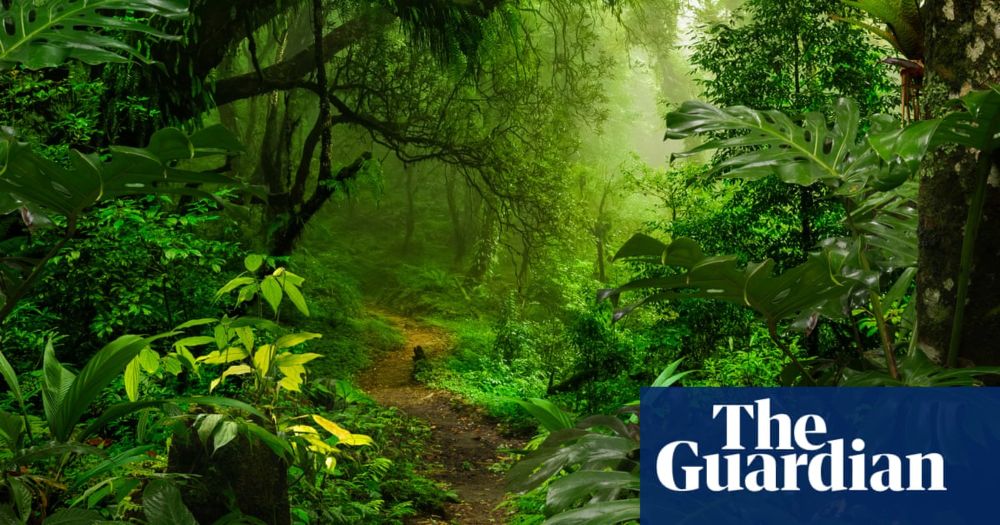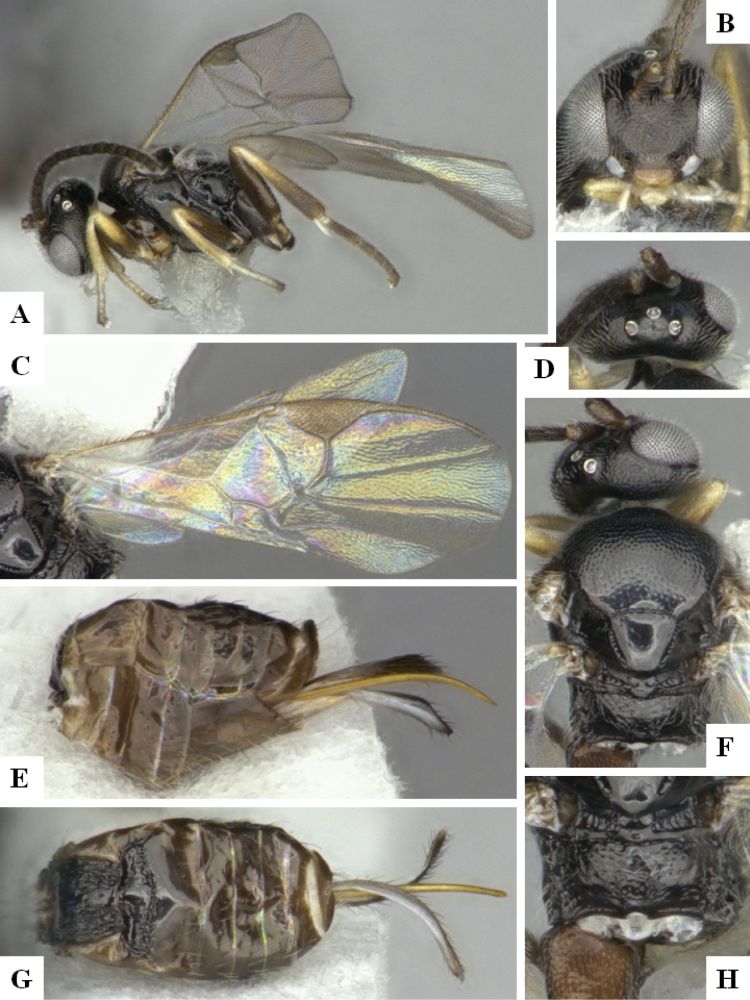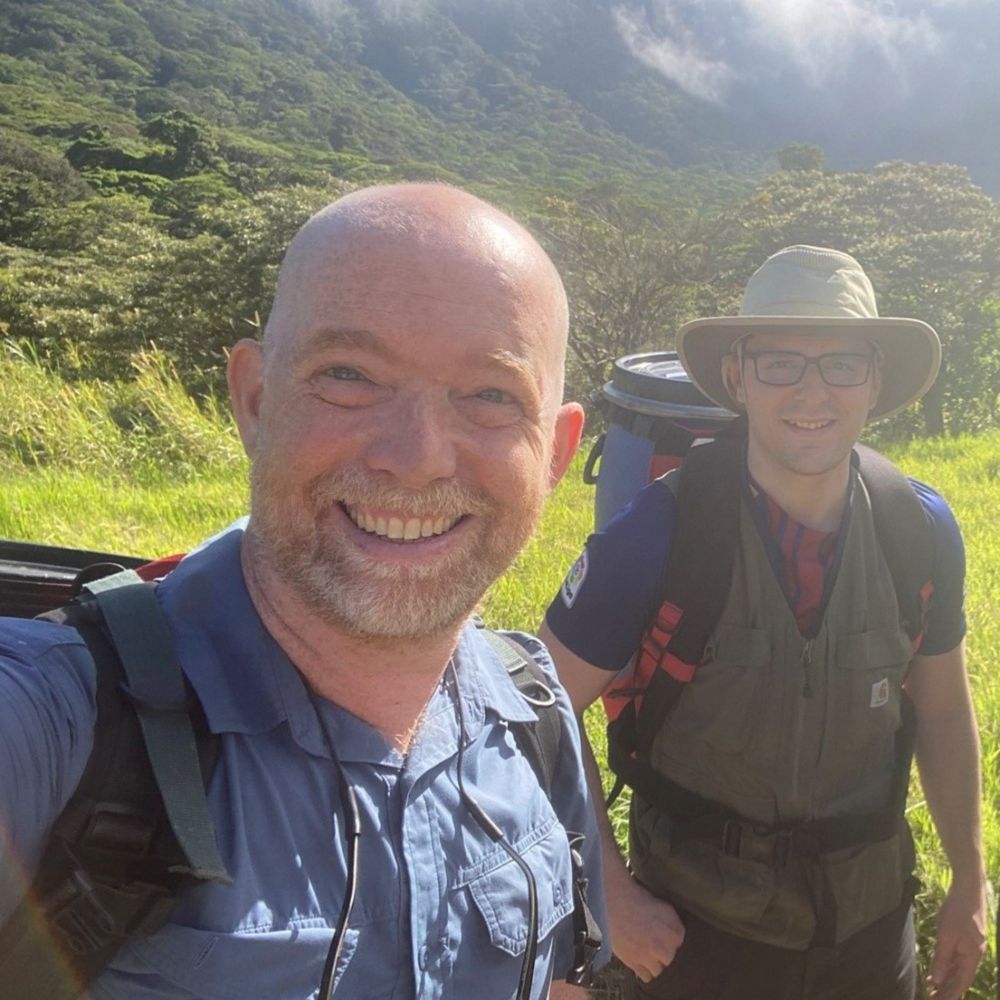"After 55 years, the world’s most ambitious caterpillar inventory will come to a close. This monumental project in ACG has reared 870,000 caterpillars, of 8,000 species of butterflies and moths, and 18,000 species of wasp parasites—all documented by a team that grew to 30 local parataxonomists."
26.09.2025 10:44 — 👍 14 🔁 6 💬 1 📌 0
Greetings from the Late Rainy Season
Happy to share our latest newsletter! The latest GDFCF and Area de Conservación Guanacaste news is here: mailchi.mp/54601d57a15d...
26.09.2025 08:25 — 👍 0 🔁 0 💬 0 📌 1

Figure of the decline of caterpillars collected in ACG over time since the standardisation of the paratxonomist workforce in 2005 (black line). The red line tracks the proportion of the collected caterpillars that were parasitised - also declining.
Lepidopteran abundance in ACG is declining (Janzen and Hallwachs 2021). While the trajectory of species within individual families may differ in the specifics from the overall trend (Figure X, Janzen and Hallwachs 2021) it is clear that in most cases, once the parataxonomist workforce stablised in ~2005 (that is – the individuals in the forests of ACG collecting caterpillars and leaves), there has been a marked decline collections of lepidoptera and their fly and wasp parasitoids. Over this same time-period, the seasonal rains in the dry forest and low-elevation rain forest have become more erratic and the temperatures of air and soil are creeping upwards in all forest ecosystems – especially the high elevation rain forest and cloud forest (Janzen and Hallwachs 2021, Smith 2023). Thus, although the evident declines documented here may not solely due to climate change – the rapidity and force of the abiotic changes to these forests are involved in these declines. Some taxa may be capable of moving upslope or towards the wetter forests of the Caribbean (Warne et al 2020), but many will, or can, not. These observations parallel other observations of reductions in the diversity and abundance of caterpillars and their parasitoids within a protected area that are at least partially due to changing climate (Salcido et al 2020).

Bipartite figure of relationships between Erebidae caterpillars and their host plants in ACG. The bipartite network of Erebidae species and host plants had a high network-wide estimate of specialisation (H2' = 0.894 Blüthgen et al., 2006) where values close to 0 indicate extreme generalization and those closer to 1 indicate specialization (Blüthgen et al., 2006). Specialisation can be visualized in Figure y by the broad blue links that connect some of the most common species of caterpillar to their host plant. For example, two species of Phaeoblemma (P. apicata and P. dares) were found only on two species of the Fabaceae, Senna (S. obtusifolia and S. papillosa). Smaller links flow out of these Senna to indicate that these species have also been, much more infrequently, food for 17 other species of Erebidae in this matrix. In another example, two Dysschema species (D. jansonis and D. leucophaea) both consume the Asteraceae Lepidaploa tortuosa – but this host plant has been found associated with 32 other species in the reduced matrix.
🧪
Very honored/excited to take part in this paper analysing & releasing 🐛 caterpillar rearing info from #ACG #CostaRica collected by #DanJanzen and #WinnieHallwachs and the #parataxonomists of @gdfcf.bsky.social
doi.org/10.3389/fevo...
Figures from data available at doi.org/10.5683/SP3/...
18.09.2025 19:57 — 👍 5 🔁 2 💬 0 📌 0

Figure 1. Four representative tachinid species from ACG. (A) Patelloa ‘xanthuraDHJ01’ voucher DHJPAR0034758; (B) Chorotegamyia sp.; (C) Spathidexia atripalpus; (D) Phosocephala alexanderi female voucher DHJPAR0048468. Photo credits - AJ Fleming CNC

bipartite diagram showing the host-specificity of ACG tachinids in the genus Belvosia. Species in red were formerly known as one species that is now known to be three by host-use and genetics. Where formalised names exist, they are largely honoring ACG paraxonomists.

Venn diagram of the overlap between the diversity of ACG tachinids known from rearing larval lepidoptera versus those that are collected in Malaise traps. Only 18.5% overlap.

Evident decline in the abundance of tachinid parasaitoids (here counts/year for the two most abundant subfamilies) in ACG after the stabalisation of the parataxonomist collection workforce in ~2005
🧪
🪰
Happy to see this large data release and analysis of decades of #tachinidae collected by #DanJanzen, #WinnieHallwachs and the #parataxonomists of #ACG @gdfcf.bsky.social in #CostaRica. So much diversity!
Paper here:
doi.org/10.3390/d170...
Data here:
doi.org/10.5683/SP3/...
🪰
🧪
23.09.2025 20:19 — 👍 13 🔁 7 💬 1 📌 0

These Bats Like to Give Hugs and Play With Bugs
Fascinating new research on spectral #bats conducted in Área de Conservación Guanacaste #hugs #murcielago #batconservation #science #costarica @plosone.org
These Bats Like to Give Hugs and Play With Bugs www.nytimes.com/2025/08/20/s...
22.08.2025 15:40 — 👍 4 🔁 1 💬 0 📌 0

How do Rufous-and-white Wrens respond when this 3D-printed owl is presented near versus far from their nest? Find out in Dr. Natalie Sanchez' talk "Singing in the face of danger" today at 16:00 in Grand Ballroom A at #AOS2025. 🦉🇨🇷🎶 @natingui.bsky.social @gdfcf.bsky.social @lincolnsavi.bsky.social
15.08.2025 19:21 — 👍 10 🔁 2 💬 0 📌 0

We are studying adult trees, saplings, and seedling composition in tropical dry forests, rainforests and the dry-wet ecotone in ACG Costa Rica to understand the future of these hyper diverse forests. #CostaRica @gdfcf.bsky.social
11.07.2025 00:46 — 👍 6 🔁 2 💬 0 📌 0
🧪
“There’s just no moths on that sheet.” @tessairini.bsky.social writes in the @theguardian.com about #InsectDecline with #DanJanzen, #WinnieHallwachs and the caterpillars of the Area de Conservacion Guanacaste #ACG in #CostaRica @gdfcf.bsky.social
www.theguardian.com/environment/...
03.06.2025 10:39 — 👍 39 🔁 25 💬 0 📌 1

‘Half the tree of life’: ecologists’ horror as nature reserves are emptied of insects
A new point in history has been reached, entomologists say, as climate-led species’ collapse moves up the food chain even in supposedly protected regions free of pesticides
Half the tree of life’: ecologists’ horror as nature reserves are emptied of insects
- A new point in history has been reached, entomologists say, as climate-led species’ collapse moves up the food chain even in supposedly protected regions free of pesticides
www.theguardian.com/environment/...
03.06.2025 08:56 — 👍 80 🔁 55 💬 3 📌 9

image from Volcan Cacao in ACG around 1000m elevation

image of Smith with Manuel and Dunia - two of the parataxonomists who work on Volcan Cacao

image of parataxonomists Manuel and Dunia walking up to the Estacion Cacao

Image of Volcan Cacao from ~1400m entering the cloud forest
On #BiologicalDiversityDay I reflect on the privilege and responsibility I feel to work with the passionate people of ACG and @gdfcf.bsky.social to help to share stories of the tens upon tens of thousands of little things that run the world.
22.05.2025 20:40 — 👍 10 🔁 1 💬 1 📌 0

Figure 111.
Dolichogenidea puschendorfi Fernandez-Triana & Boudreault holotype female DHJPAR0031864 A habitus, lateral B head, frontal C wings D head, dorsal E metasoma, lateral F mesosoma, dorsal G metasoma, dorsal H propodeum, dorsal.
🧪
New paper led by Jose Fernandez-Triana of #CNC, builds on decades of Janzen & Hallwachs #ACG @gdfcf.bsky.social collections;
A description of 102 new species of the #parasitoid #wasp genus #Dolichogenidea in @zookeys.pensoft.net including this 1 for @rpuschen.bsky.social
doi.org/10.3897/zook...
07.05.2025 14:09 — 👍 19 🔁 8 💬 1 📌 3
Late Dry Season Greetings
Our Late Dry Season newsletter is out today! Please read and share widely!
mailchi.mp/cdb7585b1111...
30.04.2025 16:01 — 👍 1 🔁 0 💬 0 📌 0

Earth Day. Every Day. Celebrating Área de Conservación Guanacaste on this #earthday and everyone working to support our planet 🌎. #earthactionday @earthdayorg.bsky.social #earthdayeveryday
22.04.2025 14:48 — 👍 4 🔁 0 💬 0 📌 0
DEPREDACIÓN DE LA SERPIENTE LIRA CENTROAMERICANA Trimorphodon quadruplex POR LA ARAÑA HERRANTE Ancylometes bogotensis EN GUANACASTE, COSTA RICA
| Revista Latinoamericana de Herpetología
A new publication by GDFCF Science Advisor Roberto Fernández regarding a novel case of spider-snake predation in Costa Rica. #snake #spider #CostaRica #predation #reptiles #serpientes #arañas #behavior
herpetologia.fciencias.unam.mx/index.php/re...
05.04.2025 11:36 — 👍 1 🔁 1 💬 0 📌 0

#tbt to 1986. Dan and Winnie in the field in Área de Conservación Guanacaste processing Lepidoptera specimens. Photo by Bill Fasth. #history #lepidoptera #biodiversity #mariposa #butterflies #moths #science
02.03.2025 19:16 — 👍 8 🔁 2 💬 0 📌 0

Screen grab of article in Irish Times that reads
A shocking collapse: forests that once showed traces of insect life on every leaf often now appear ‘fumigated’
‘The house is burning. We don’t need a more sophisticated thermometer, we need a fire hose,‘ says a resident expert at a unique conservation area in Costa Rica
Resident Expert is Dan Janzen and Winnie Hallwachs
Underneath is the image of a larval stage of the lepidoptera Calydna sturmula
"The house is burning. We don’t need a more sophisticated thermometer, we need a fire hose" Dan Janzen & Winnie Hallwachs
@paddywoodworth.bsky.social #IrishTimes re. #ACG and the crisis in #Insect #Biodiversity
@gdfcf.bsky.social @irishrainforest.bsky.social
www.irishtimes.com/environment/...
06.02.2025 14:12 — 👍 36 🔁 10 💬 0 📌 0
Thank you, @alexsmithants.bsky.social! Glad to be here. Please give us a follow!
06.02.2025 12:10 — 👍 9 🔁 3 💬 0 📌 0

Yesterday, I returned from 3 weeks in Costa Rica, where I went to find out what can be learned from their spectacular success rewilding a country.
I cannot overstate how awe-inspiring the trip was: nature loss CAN be reversed on a huge scale, benefiting *everyone*.
05.02.2025 08:29 — 👍 1290 🔁 266 💬 29 📌 20
🌱Ecology🌻Botany🌲Forests🌳Biodiversity🦋Mountains🏔️Climate🌦️Professor🌳NSF Mid-Career Award🍀Editor, Ecological Applications🎋Past Chair, ESA Vegetation (2021-2023)🍁 Fellow, Yale School of the Environment (Fall 2023).
https://www.esf.edu/faculty/dovciak/
NorBOL is a network of Norwegian institutions and a national research infrastructure for DNA barcoding in Norway. Moderated by Torbjørn Ekrem
Biology Professor & Associate Dean @UWindsor. I study bioacoustics, behaviour, and birds. Husband & father. Proud Canadian 🇨🇦. I post about our team's research adventures. www.uwindsor.ca/dmennill
Aquatic entomologist, kayaker, naturalist
Ed: Newsletter of the Biol. Surv. Canada & Mayfly Newsletter
born at 314 ppm
Professor Emerita at UPEI, Fellow of the ESC
Retired home to BC's spectacular Sunshine Coast
Lecturer in global change ecology, Bangor University | Population ecology | Food caching | Microbiomes
Postdoctoral researcher @ The Hawkesbury Institute, Australia.
Plant ecologist and rainforest enthusiast 🌳
Biólogo - Ecología de comunidades de plantas. Bosque seco tropical. PhD student in Dr. Hulshof's Lab at @VCU 🌳🌴🌵
Wildlife, trees, terrestrial ecology, night, trees, corvids, coffee, cats. | Nocturnal (DSPD). AuDHD. They/them.
My nonhuman animal equivalent is the badger.
"Night is a world lit by itself."
—Antonio Porchi
O mundo da biologia em artigos de interesse
biologo.com.br
Forests across the planet are under threat. We need to act urgently to not only protect our existing forests, but to allow forests to return where they once were.
field station co-director, tropical plant ecologist, bird enthusiast, admirer of all things imaginative and well-crafted
Chicana ecologist and poet. Bilingüe. Biodiversidad y cambio climático. Associate Professor. Fulbright CSIC. Geopoetics. biodiversityresearchlab.com
Mark Day - Conserving & restoring nature @ speed & scale, passionate about freshwater ecosystems & grasslands.
Co-Founder of @AltynDala.bsky.social
@EarthshotPrize.bsky.social winner 2024 ‘Protect & Restore Nature’ + ‘UN World Restoration Flagship’
Biodiversity | Ecology | Physiology | Theory | Climate Change | Macroecology | Scaling | biendata.org; Prof. EEB Univ of Arizona, External Prof Santa Fe Institute, Hon Assoc Res Oxford Univ UK; Proud father, Gift med en svensk🌵🇺🇸🇬🇧🇸🇪🌲
Systematic Entomologist focusing on Heteroptera (True bugs) | Taxonomy and biodiversity | Curator of the Entomological collection Instituto de Ciencias Naturales (ICN) | chinchólogo | profe #UNAL
https://tinyurl.com/3wskrrrp
Bogotá- Colombia 🇨🇴
Transposon obsessed biologist #TEsky. Research Associate in Adamowicz Lab and Linquist Lab @ the U of Guelph
Check out the wealth of TE resources on @tehub.bsky.social https://tehub.org
https://www.tyleraelliott.com/research
📸 Photographer | capturing life's candid moments with my camera 📸
🌍 https://rupertrivett.photoshelter.com 🌍
#RealStreetPhotography #Photojournalism|
Skilled in unobtrusive, authentic #storytelling
📣NEW SUBSTACK 📔
👇📸👇📸👇📸👇📸
https://rupephoto.substack.com/
Open-access, peer-reviewed journal for taxonomy, phylogeny, biogeography, and evolution of animals of any geological age from any part of the world.
Published by @pensoft.net. Powered by ARPHA Platform.
Website: zookeys.pensoft.net
Ecologist, entomologist, writer. Chair of Academic Senate and Professor at CSU Dominguez Hills. ScienceForEveryone.science and I'm the Small Pond Science guy.
he/him
Black Lives Matter. In favor of DEI, justice, access, opportunity. Abolish ICE.




























